I-375 revision would mean fewer travel lanes, but residents still have questions
It was hard to get past the width of the roadway.
Nine lanes of traffic.
That’s how wide parts of a reimagined Interstate 375 appeared in numerous presentations, only not as an interstate in a trench splitting downtown Detroit from Lafayette Park and other east-side areas but as a street-level boulevard.
It gave critics ample room to question the “Reconnecting” portion of the I-375 Reconnecting Communities Project name or how it could ever address the elimination of areas like Black Bottom and Paradise Valley decades ago.
One neighborhood group, the ReThink I-375 Community Coalition, even launched a letter campaign to Gov. Gretchen Whitmer and Mayor Mike Duggan in April seeking to have the Michigan Department of Transportation removed from its role leading project design, saying in a sample letter that the effort as envisioned would actively disconnect the community and threaten decades of stability.
But MDOT is now offering a revised vision for the project, one with fewer lanes following an analysis in recent months showing less traffic during the morning and evening rush hours than before the pandemic.
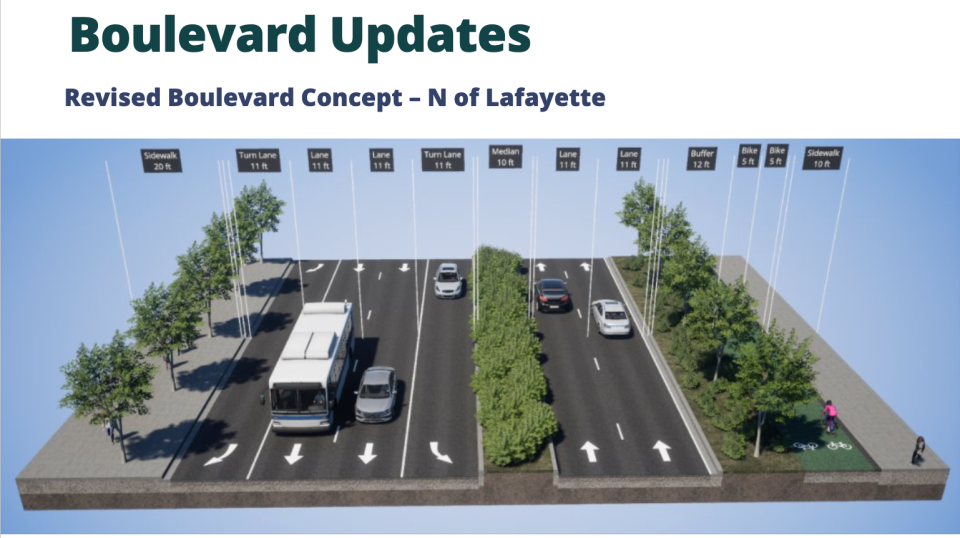
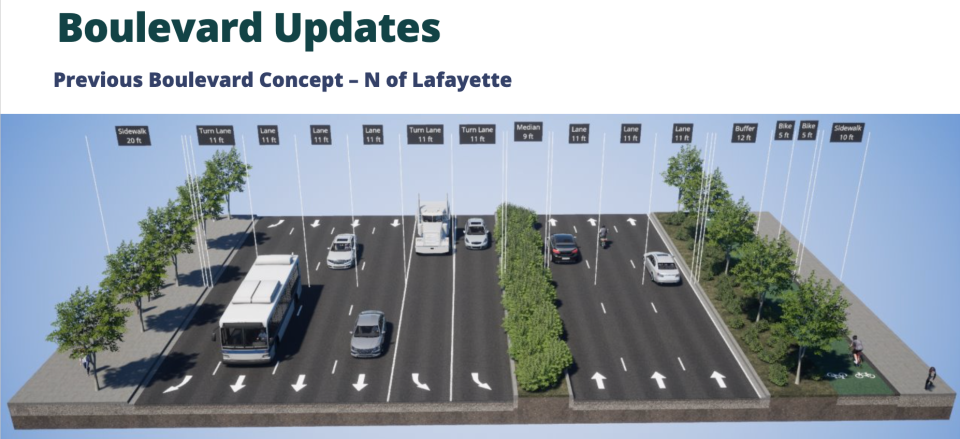
Instead of nine lanes, the boulevard would be six, according to an MDOT presentation slide showing a possible view of the area north of Lafayette. Instead of three through lanes in each direction, there would be two. Instead of two left turn lanes in one direction, there would be one turn lane.
MDOT in an April webinar called it a 33% reduction in the travel lane width, and Project Manager Jon Loree said in an email that the department's traffic analysis forecast "a 20% to 40% reduction in the new boulevard based on time of day and location. This allows us to reduce the boulevard cross section, maintain mobility, and will result in a more comfortable pedestrian experience."
While the revisions appear to address some concerns from mobility advocates, who have been vocal that crossing so many travel lanes on foot or a bicycle or a wheelchair would be dangerous, not everyone is convinced the project has the right focus in mind, even with the changes.
J. Gregory Love, a former Detroit executive deputy fire commissioner, said he is “concerned about the lives that are going to be lost” when an interstate connection between east-side neighborhoods and the Detroit Medical Center is transformed into a signalized surface street.
He predicted that ambulances serving the thousands of residents, many of them senior citizens, living in high-rise buildings along the East Jefferson corridor, would see additional minutes added to hospital trips. He said those trips happen every day, and the issue highlights how the project will affect residents and neighborhoods beyond Lafayette Park.
“When they raise the freeway, they’re going to have an extension of that ride, probably eight to nine minutes longer,” said Love, who is president of the Indian Village Manor Condominium Association.
Love said he’s focused on being a voice for the seniors on the east side of Detroit, many of them at a deficit in terms of internet connections whose concerns aren’t as visible as others. He emphasized that he’s “staying in the lane” of public safety, something he knows best, in his comments about I-375.
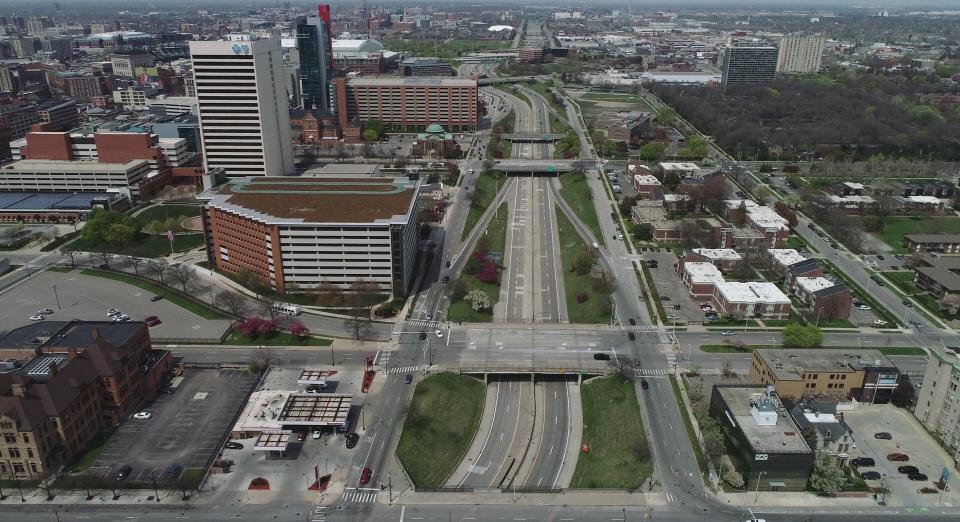
In response to the emergency response concerns, MDOT's Loree provided documents from the preliminary designs shared with various groups last year showing travel times between Lafayette Park and the DMC. The estimated travel times range from five to six or seven minutes using the existing route and from seven to eight to as much as 13 to 14 minutes, depending on the time of day, using four alternative design route options.
Loree noted that "in response to the feedback we received, we have developed a number of design refinements made possible by a reduction in recent traffic volumes. This includes adding new local connections in the interchange that will enable emergency vehicles to take the 375 boulevard north into Brush Park and a direct connection from the 375 boulevard to the northbound I-75 service drive that connects to Mack. Travel times for these new connections are under development."
'Severing an artery'
The stakes are high for this project, which has been discussed at least since 2013, and residents and public officials know it. Federal money is involved, including a $105 million grant that U.S. Transportation Secretary Pete Buttigieg came to Detroit to announce in 2022.
The project, including the reconfiguration of the I-75 interchange, has been estimated to cost $425 million. It would see major construction in 2026-28 and completion in 2029, according to the latest plans.
I-375 and the effort to reimagine its next phase have been tied to the understanding that such highway projects and the urban renewal efforts they were connected with displaced many minority and immigrant communities across the country at a time in the last century when those communities’ concerns did not receive due consideration. MDOT says the purpose of the project is to create a safer road that can meet current design standards and improve connectivity in place of an aging highway that's six decades old.
Reimagining the roadway, which could free up substantial land for reuse or redevelopment in some fashion, carries the weight of trying to address the history of the area in a way that serves the community for years to come.
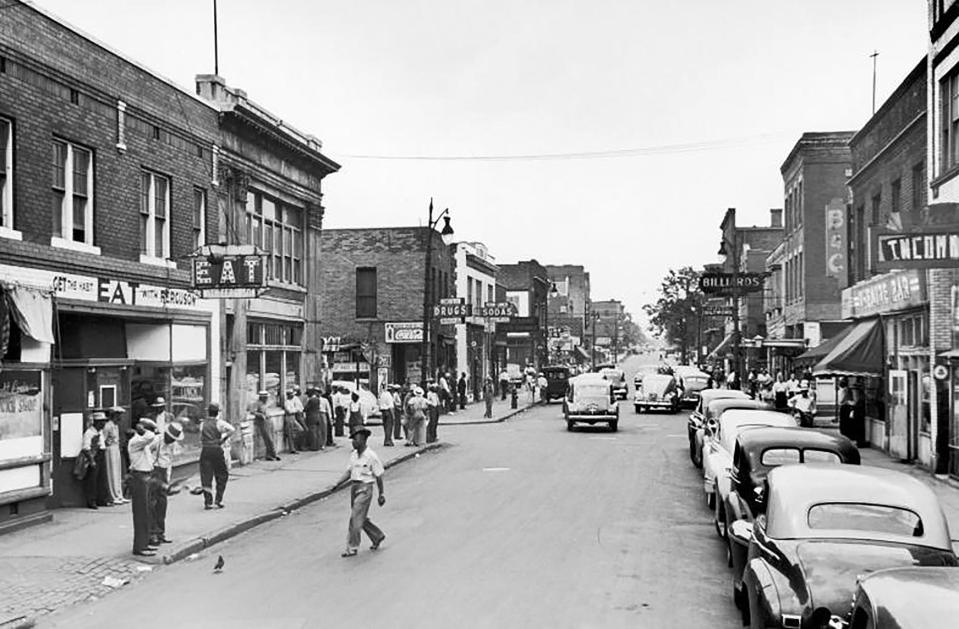
But Love, whose aunt had lived in Black Bottom and was pushed out, echoed what some critics contend, that history could be repeating itself in a sense, in the way the project is playing out.
He dismissed the notion that the project would reconnect a community.
“What community are you reconnecting? You’re severing an artery,” he said.
More: I-75 in Detroit could look much different in the coming years. Here's how
The need for a vision
Olga Stella, who has lived in Lafayette Park for 25 years and is part of the group leading the letter-writing campaign, said she can’t comment yet on whether the revisions are adequate because she hasn’t had an opportunity to “dig in.”
The idea behind the letter, which Stella said Friday is being finalized, was to let public officials know how concerned residents are with this project. She declined to specify how many people had signed the letter, but allowed that the group had exceeded its goal of 100 signatures.
“There’s a characterization that there’s a very small group of people who have concerns. That’s not the case,” she said.
MDOT's Loree, however, defended the process.
"The public engagement process is working. Through our Local Advisory Committee and our neighborhood meetings, we heard concerns and have addressed them through the design refinements. We are still early in the design process and look forward to continuous engagement that will help move the project forward," he said in a response sent to the Free Press.
Determining the land use for the area that is freed up from the project is another key part of what's ahead, a process that has yet to play out and will be led by the city. Numerous critics have said that process should have happened before design began.
“This is a project that will shape our city for the next 50 years in the same way that the original I-375 shaped the city up to this point. It’s very important that we get this right,” Stella said. “What should be driving this project is a vision.”
That vision, she said, has been lacking up to this point.
It’s also not clear to Stella or others how much of the project can be changed going forward despite what they've heard from MDOT.
Loree said in April that most of the design work remains ahead and that the department is “still in that mode where we can consider design changes.”
“We’re certainly open to looking at opportunities to add connections … to add mobility,” he said during the April public session.
MDOT will be looking at how the framework planning can feed the future design as well as “how we honor Black Bottom,” Paradise Valley and the history of those neighborhoods, he said.
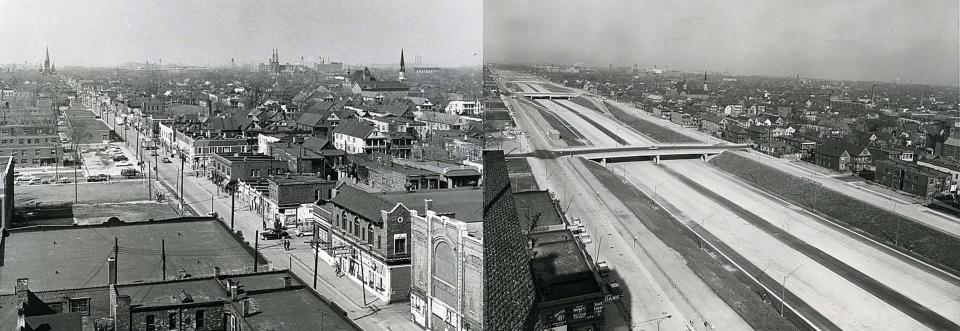
Some changes, however, can’t be made, he said, pointing to those that would negatively affect safety and those that would affect adjacent properties.
More: Ford Road project would mean no left turns
'Cautiously happy, optimistic'
The changes to the roadway design are a welcome adjustment to some.
Todd Scott, executive director of the Detroit Greenways Coalition and a member of a local advisory committee for the project, said he was excited to see what MDOT had come up with, and his sense from a recent meeting was that some people believe MDOT is beginning to build trust and listen.
“I think it’s a big, big change. I’d say some people are cautiously happy, optimistic … (but) everyone’s not, ‘we’re done, high-fives,’” Scott said, noting that while there appears to be good biking connections downtown and to Eastern Market, he remains unclear on connections to Brush Park, for instance.
But the revisions would make a real difference to the impact of the roadway, he indicated.
“They were originally planning to build a Telegraph Road through downtown, and now they’re planning to build a Mack Avenue,” he said, highlighting the shift in view to a local road that is less challenging for vulnerable road users.
Eric Larson, CEO of the Downtown Detroit Partnership, said that most everyone feels that the reduction to six lanes is an improvement.
“Have we gone far enough? That’s the continuing consideration,” he said. “We are encouraged by the progress and the changes that were presented … we are continuing to work very closely with the community, MDOT and the city to look at further changes, further opportunities and additional ways to incorporate the community’s input and concerns.”
Larson said he’s encouraged that the “right conversations” are taking place now.
“All of us want to make the most of a transformative project,” he said, noting that it goes beyond the number of lanes to what the broader vision is for transportation and mobility.
DDP is getting support from The Kresge Foundation through a $1.85 million grant “to maximize the potential of the I-375 project and to ensure that residents and businesses are fully engaged in the process to bring the interstate to grade,” according to a statement from Jennifer Kulczycki, a spokeswoman for the foundation.
She noted that “we are also convening a reparative roundtable made up of community members from across the city to ensure that the project is responsive to (the) community and is as creative, restorative, aspirational and equitable as it can be.”
Contact Eric D. Lawrence: elawrence@freepress.com. Become a subscriber. Submit a letter to the editor.
This article originally appeared on Detroit Free Press: I-375 to boulevard revisions would shrink road footprint in Detroit

